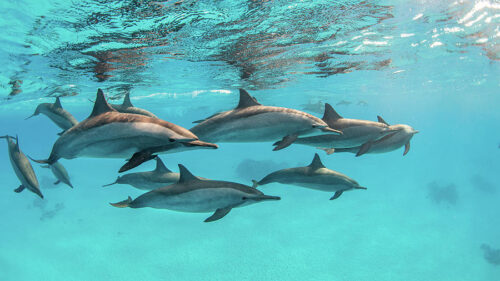Dolphins are celebrated for their acrobatic displays and friendly demeanor, intriguing people around the world.
Whether observing wild dolphins or those in captivity, many are drawn to their intelligence and charm.
However, beneath the surface, many wonder: are dolphins dangerous? Reports of attacks on humans and the sight of their tiny sharp teeth can spark concern.
In places like Hawaii, for example, where dolphins and humans often interact, this question takes on added significance. Take when swimming with dolphins in Hawaii tours for example.
In this article, we’ll delve into the various behaviors of these intelligent animals, from the bottlenose dolphin to the playful river dolphins, and seek to answer the question: are dolphins dangerous?
Dolphins as Social and Intelligent Animals
Within the animal kingdom, dolphins stand out as exceptionally intelligent animals. They’re not just a marvel to watch but are known for their complex social structures and behaviors, particularly in the wild.
A pod of dolphins, whether common dolphins or the more widely recognized bottlenose dolphin, exhibits intricate communication methods and cooperative hunting techniques.
Dolphins are often compared to humans in their intelligence. They create alliances, show empathy, and even pass on unique behaviors to their offspring.
Female dolphins, for example, have been observed teaching their young how to use tools like marine sponges to protect their snouts while foraging.
These characteristics not only make dolphins captivating but raise intriguing questions about their relationship with humans.
Be it wild or captive, dolphins’ social complexity and intelligence set them apart. However, does this intelligence translate to a threat, or is it a testament to their harmonious existence with human life?
Dolphins in the Wild vs Captivity
Dolphins inhabit a wide range of environments, from the open ocean to specialized aquariums. Understanding the difference between wild dolphins and dolphins in captivity is crucial to grasp their complex behavior fully. You can even swim with dolphins in Oahu.
In their natural habitat, such as the sparkling waters of Shark Bay or the Amazon River, dolphins live in tight-knit social structures.
Wild dolphins often travel in pods and exhibit behaviors that adapt to their natural environment. They hunt, play, and interact in a way that reflects the freedom of the open sea.
Contrastingly, a captive dolphin’s life is markedly different. In settings like marine parks or aquariums, their space is restricted.
Dolphins in captivity often exhibit signs of stress or altered behaviors. An adult bottlenose dolphin, for example, might not demonstrate the same playfulness or complex social interactions as its wild counterparts.
Such differences between wild and captive lives can significantly impact a dolphin’s behavior, particularly in contact with humans.
Hence, while a captive dolphin may seem more approachable, it might not necessarily mean they’re harmless. The question of how dangerous they are extends beyond their living conditions and dives into understanding the underlying changes in their nature.
Human Influence on Dolphin Behavior
The impact humans have on dolphins, both in their natural environment and captivity, is a subject that warrants exploration.
How does human activity, intentionally or unintentionally, influence dolphin behavior? Are dolphins dangerous as a result of our actions?
Tourism, for example, draws many to witness the beauty of wild dolphins. Yet, in places like Hawaii, where interaction is prevalent, this close contact with humans can lead to altered behaviors.
Fear of humans or a desire for human food might provoke unexpected reactions. Fishing practices may also lead to more aggressive behaviors, as dolphins compete with humans for the same prey.
Pollution and habitat destruction further complicate the relationship between dolphins and humans.
From the mighty Amazon River to the rich marine life of Shark Bay, our actions can disturb the delicate balance of these ecosystems, leading to stress or unnatural behaviors in dolphins.
Even in captivity, where interactions are controlled, human management practices may lead to injuries or severe blunt-force trauma, highlighting the need for an ethical and informed approach.
Are Dolphins Actually Dangerous?
The answer here isn’t a straightforward yes or no. Why, you might wonder? Well, while the majority of interactions are peaceful, there have been instances where dolphins have inflicted harm.
Dolphin attacks towards humans are rare but not unheard of. From deep punctures to dozens of bites, these incidents can be a terrifying sight.
However, it’s essential to recognize that fatal dolphin attacks are exceedingly uncommon. Plus, the factors influencing dolphin behavior vary.
A wild dolphin might react unpredictably due to fear of humans or competition for food, while a captive dolphin might respond aggressively due to stress or confinement.
An adult bottlenose dolphin in captivity may exhibit entirely different behavior than one in its natural environment.
Finally, the danger posed by dolphins is minimal, especially when considering other marine life threats like shark or white shark attacks.
How to Safely Interact With Dolphins
Understanding how to deal with these intelligent marine mammals appropriately is crucial for both human safety and the well-being of the dolphins. So, here are some tips to follow when you spot a dolphin:
- Avoid Feeding: Offering human food to dolphins disrupts their natural diet and hunting habits, possibly leading to unnatural or dangerous behaviors.
- Follow Local Guidelines: Different regions, like Hawaii, have specific guidelines for interacting with dolphins. Adhering to these rules ensures a safe and enjoyable experience.
- Educate Yourself: Understanding dolphin behavior, such as recognizing signs of stress or aggression, can help prevent unexpected incidents.
- Promote Ethical Practices: If visiting a facility with dolphins in captivity, ensure that they follow ethical practices regarding care and human interaction.
- Enjoy from a Distance: Sometimes, the most respectful way to appreciate dolphins is from afar. Observing them in their natural environment, such as the shallow waters of Shark Bay, offers a glimpse into their world without intrusion.
Conclusion
So, are dolphins dangerous dolphins? Sadly, the answer is complex. While there have been incidents, they’re infrequent and often linked to specific circumstances.
By approaching these intelligent marine mammals with awareness and respect, the risk of harm is minimal.
Dolphins remain a captivating part of our world, known more for their beauty and intelligence than any potential danger. Hence, we recommend reading and learning more about them before judging them too hastily!

